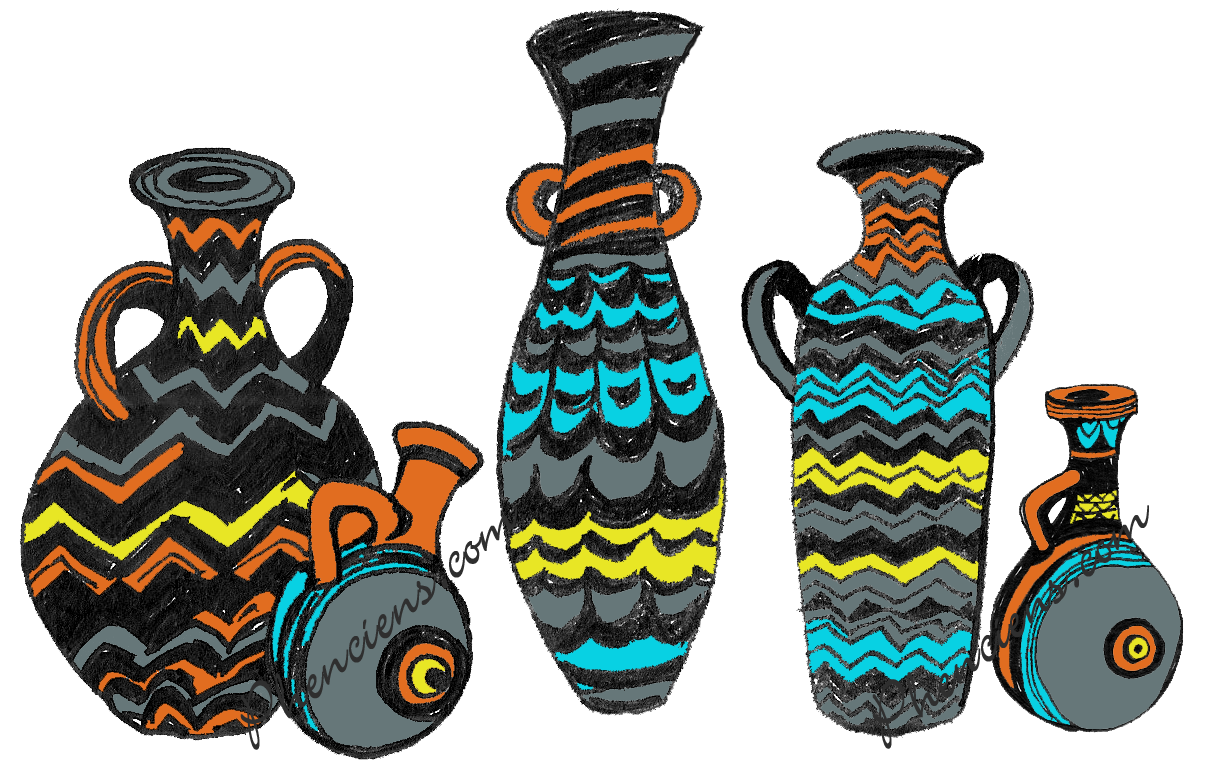The Art
The Phoenician art is known to be a composite art based on documents by themselves cosmopolitan. Its originality is far from being unique and innovative; it is one of a diverse, popular and "propagandist" art. It is mostly the result of imbrication of various elements of influence in a country located at the crossroad of ancient world, subjected to considerable foreign presence, and frequented by various civilizations.
It has often been alleged that Phoenicians (their tendency) tended to imitate and counterfeit. They were accused, rightly or wrongly, to copy their neighbors, and not have their own personal creativity. Conteneau, in his book "La civilisation phénicienne", divided Phoenician's art into two eras: "The first goes from the origins uptil the early first millennium BC, during which the Phoenician art seemed an imitation and adaptation from Egyptian or Aegean art, and generally from many other foreign countries. The second period, from the first millennium BC uptil the end of the Greco-Roman age, when art was no longer considered imitation, but a coordination, and and compilation into a homogeneous art".
The originality of the Phoenician art is in adapting various artistic tendencies of this period to the taste of receivers. The major innovation is to have made art closest to daily use, accessible to everyone. Art was no longer restricted to a certain social class, it became a mass-product carried by the Phoenician traders in all regions around the Mediterranean and beyond(1).
The Phoenician art was not reduced to a specific environment, it was also vast as well as varied: glass work, ceramics, metal, ivory(2), the creation of jewelry and beauty accessories, purple color manufacture, currencies ... not forgetting architecture and sacred art.
The glass work
Pliny, the historian, related a tale about glass discovery by Phoenicians: The story says that in the south of Tyre, a Phoenician ship was docked. The sailors went down to the coast and collected rubble stone of potassium nitrate, to maintain their fire. So, few hours later, they found that the nitrate was dissolved and amalgamated with the fine sand of the beach. The consequence was a remarkable effect of color, form and aspect. This was the first revelation of the glass.
The question of glass invention splits historians, some attribute it to the Phoenicians, others to Egyptians, by specifying that the role of the Phoenicians was simply the reproduction and distribution. According to the latest theories, the glass industry would be Mesopotamian. From there it would have passed to Egypt, to flow back to the Levantine coast, in accordance with a process related to the historical changes and political influence in the region.
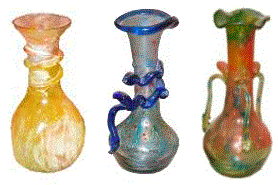
Glassware - Handicraft
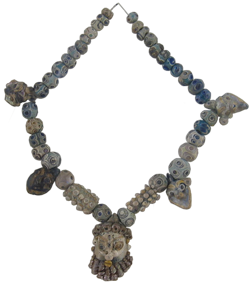
Necklace glass paste, Louvre
Between the scientific fact and legend we can be summed up to say that the glass, manufactured and propagated by the Phoenicians, was tinted with rich colors and variegated, covering various forms, depending on the purpose for which it was intended. For the current use of daily life we find cups, flasks and unguent phials, whereas for luxury use, they manufactured glass pearls and pendants for jewelry.
Even if we are now able to confirm that the role of the Phoenicians was limited to ensure continuity in glass manufacturing in general, all historians have since attributed the invention of blown glass to them. This art was for a long time a specialty of Sidon's city, and its sailors have spread it all around the maritime roads, from Mediterranean east coast to most known countries in the ancient world.
The ceramic work
The study of the Phoenician pottery did not have the same interest as for Greek pottery. This is mainly due to the simplicity of the Phoenician manufacturing that could never compete with the aesthetics and magnificence of the attractive Greek production.
The ceramic work of the Phoenician cities was derived directly from the Syro-Palestinian pottery which existed since the end of the Bronze Age. It was a multi-purpose product: domestic, commercial and funeral. It was divided into two classical forms: open forms and bolted forms.
The function of each product was related to its shape: open vessels such as plates serving to food. Bolted vessels, such as amphorae, sealable, were intended for the preservation or transport of foodstuffs (wheat, wine, oil ...). Jugs to drink or to pour liquids, distinguished with a lip "cut square". We also find some jugs provided with a long beak attached to the paunch at the lateral side, with a filter at its base. Some jars could have funeral usage, the amphorae were frequently used in the tombs, as cremation receptacles, sometimes sealed with plates, serving as a lid.
The vases manufactured in Phoenicia were also influenced by models from the neighboring countries (Cyprus or Samaria). We observe the presence of jars imported or imitated, their provenance or inspiration originates from the Western countries: Greece, Sicily and other territories where the Phoenicians had settled, like Sardinia and the Iberian Peninsula.
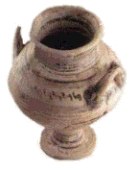
Phoenician potteries
Artisanal manufactures
What could be more attractive than jewelry? What could be lighter to carry? Or, what is especially more profitable as a product? The Phoenicians realized quite early the impact of such commerce, so they worked for its expansion and development with the beginning of their exploration. As with regards to the materials used, they transformed at first the gold, which is best preserved, and it was the most commonly used. Silver was much less used due to its deterioration over time. Bronze, precious stones, as well as glass were frequently employed in the composition of jewelry.
The decorative patterns were especially inspired by the Egyptian style, the most recognized at that time and most sought for. A preference was given to vegetal motifs like the lotus flower or the rosette, and to animal motifs such as scarabs, hawks, lions and sphinx.
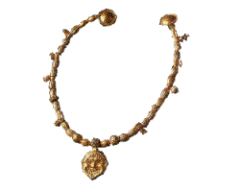
Jewelry & Phoenicians Accessories
Among the jewels most often manufactured within the Phoenician production, we find some earrings in gold mostly in the form of crescent moon or solar disk, bracelets, rings and necklaces ornamented with glass pearls, and various pendants.
For the industries of the bronze and the ivory, Phoenicians excelled in their production, despite the fact that the raw material for these industries were sought in faraway lands. The ivory came from India through Chaldea, Arabia and Egypt. For the bronze, a tin-copper alloy, Phoenicians brought the copper from Spain, and the tin from the British Isles. The Warehouses of the islands of Malta and Cyprus served as storage spaces for these imported products.
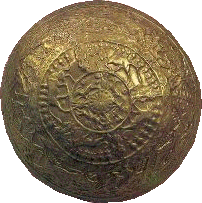
Decorated armor & daggers
The Phoenician production was widespread in all the countries of the antique period, it was art in the service of beauty, but also in the service of trade and a means of enrichment for the sailors-traders who navigated on the seas in search of new markets. These products were often coveted by the greedy conquerors of wealth of the coast who filled their palaces with the spoils of war.
In the spirit motivated by commerce and trade, the Phoenician artisans have their work in the service of expansive and transportable art, hence the appearance of these arts "minor" called "athyumata"(3) by the Greeks. The majority of these produced articles had a double value; utilitarian and artistic.
The purple industry and textile manufacturing high quality aroused envy and enthusiasm of all the purchasers who awaited the arrival of Phoenician ships. Wearing purple clothing remains until today, representative of a privileged social class. Unfortunately, with time effects not allowing any conservation in this area, the only traces that have survived are reduced to the writings of ancient authors. At present some scientists working on the reproduction of the purple color from murex, are approaching the ancient Phoenicians manufacturing.
Urbanism and architecture
We can safely say that nature has been a fact in the choice of urbanization among the Phoenicians. Most cities were constructed on promontories near a shallow pond or lagoon to moor their boats easily, or on islands at a short distance from the coast. This type of installations offered to ships the best possible conditions to shelter them, and improved immune defense system. Headlands are naturally well protected sites, so can accommodate a fortified construction, while the islands are less easy to attack than the positions on plains within the mainland.
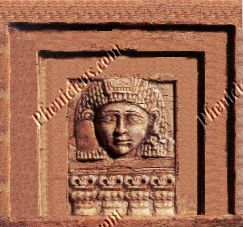
Lady at window
The organization of the Phoenician settlement in the city presented a consistent morphology. The central core consists of an acropolis, surrounded with walls, and all around are grafted residential neighborhoods, religious edifices, construction intended for commercial and industrial activities.
The sanctuaries were sometimes located in a reserved area of the city (like the Temple of Echmoun, Bostan esh-Sheikh, Sidon, or Phoenician temple in Tyre from the end of the Persian period), hence becoming a "sacred area". Burials were also installed outside the residential districts. The Phoenician tombs were established either in pits or as wells (royal tombs at Byblos) or "dromos" i.e. passage with a sloping ramp leading to a grave.
Be aware that the information in this area remains reluctant, as archaeological research has always been constrained by the superimposition of antique and modern installations. It is primarily due to the archaeological documentation of neighboring countries, that historians have been able to reconstitute the living environment of the Phoenicians. The example of engravings Assyrian (relief from the palace of Sennacherib) provide testimony regarding private constructions, the famous storey homes, entrances flanked with columns and windows with balustrades.
If we do not have significant knowledge about Phoenician architecture and their urban installations, we cannot forget one of the most impressive achievements mentioned in the Bible, the Temple of Solomon in Jerusalem, which was built by workers from the city of Tyre under the direction of famous architect Hiram.
In addition to urban planning and architecture, we can also mention the various stone buildings such as steles, reliefs, statuary and sarcophagi (the most famous being that of Ahiram King of Byblos and that of Echmounazor King of Sidon) who were subjected to Egyptian influence, and a few centuries later, to the Greek artistic inspiration.
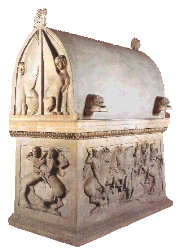
Lycian sarcophagus
| (1) |
M. Chéhab nota dans Les Phéniciens. L'expansion phénicienne. Carthage, Gallimard, 1975, p.32 : Placé au carrefour du monde ancien, le Phénicien vit de moins en moins en isolé ; marin et commerçant, il aura des contacts de plus en plus constants avec les pays étrangers, dont son esprit vif assimilera rapidement les arts et les exprimera sans jamais pour autant en faire un copiste servile. Quelle que soit l'influence étrangère dont elles sont pénétrées, ses œuvres ont toujours porté la marque de sa personnalité. |
Retour texte |
| (2) |
Fady Stéphan, Les Ivoires Phéniciens, 2000 ans d'art en Orient, Université St-Esprit Kaslik, Liban, 1996. |
Retour texte |
| (3) |
Les Phéniciens, sous la direction de S. Moscati, Stock, 1997. |
Retour texte |
